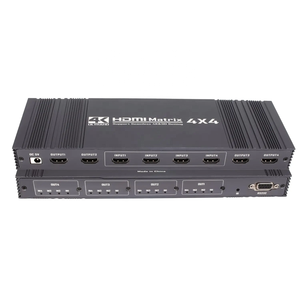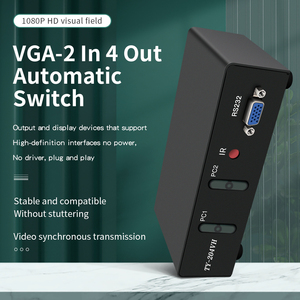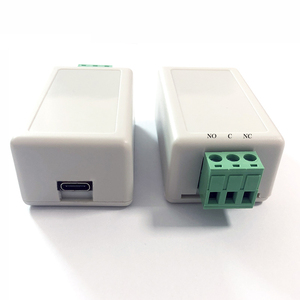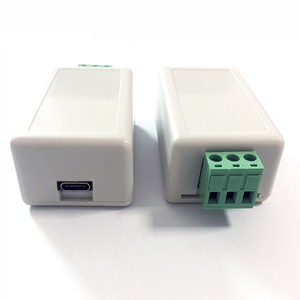(1044 products available)

































































































































































































An RS232 splitter box is mainly used to take one input signal and split it into multiple outputs. It enables users to connect one RS-232 device to multiple other devices or computers. These splitter boxes come in various types designed to cater to different needs.
The first common type is the Dual port splitter. Dual port splitters have one input port and two output ports. Organizations or companies whose work involves testing cables often use them. They allow users to take one output signal and split it into two, thus enabling two devices to receive the same signal.
The other common type is the four-port splitter which is an upgrade of the dual-port splitter. It has one input port and four output ports. Some models can have LED indicators that show port activity. They are commonly used in control systems where one computer must control multiple devices.
Eight-port splitters have one input port and eight output ports. They are used in larger systems where one RS-232 signal must be distributed to eight different devices.
An RS232 splitter box is mainly used to take one input signal and split it into multiple outputs. It enables users to connect one RS-232 device to multiple other devices or computers. These splitter boxes come in various types designed to cater to different needs.
The first common type is the Dual port splitter. Dual port splitters have one input port and two output ports. Organizations or companies whose work involves testing cables often use them. They allow users to take one output signal and split it into two, thus enabling two devices to receive the same signal.
The other common type is the four-port splitter which is an upgrade of the dual-port splitter. Dual port splitters have one input port and two output ports. Organizations or companies whose work involves testing cables often use them. They allow users to take one output signal and split it into two, thus enabling two devices to receive the same signal.
Four-port splitters have one input port and four output ports. Some models can have LED indicators that show port activity. They are commonly used in control systems where one computer must control multiple devices. They are an upgrade of the dual-port splitter connecting two RS-232 devices to one console or source.
Eight-port splitters have one input port and eight output ports. They are used in larger systems where one RS-232 signal must be distributed to eight different devices. Some advanced models include LED indicators that show status for each output port.
Connection and Distribution:
The main function of an RS232 splitter is to connect one RS232 device to multiple computers. For example, connect one scale to multiple cash registers or connect one card reader to multiple ATM machines. This reduces cable clutter. It is also used where multiple access points are needed, like accessing a modem from different computers. All information from the primary port goes to all secondary ports. Certain splitters allow information from a device to go to one of several computers. These splitters have buttons or software controls that let the user choose which computer to send data. Some models have features that keep the data cable straight, like automatic data switching or user-friendly cable management.
Multiple Outputs:
Various models are available for different distribution needs. This includes 2,4,8,16,32, and 64 port options. Eight ports are the most commonly used model.
Provide LED Indicators:
Some splitters have LED lights to show if data is being received and sent. This helps troubleshoot connection problems. Important splitter features include maintaining signal integrity, being bus-powered without needing an external power supply, and being compatible with different operating systems like Windows, Linux, and Mac. Two types of splitters exist: the first copies data to multiple ports, and the second sends data to one port that can switch between ports. This second type is also known as a data switch or data selector.
Various industries that rely on serial communication employ rs232 splitters in their operations. They use it to facilitate the transmission of data to different locations.
Compatible Port:
Having a similar connector is vital because, in the case of splitters, many will have a different type of port number than the one they are receiving the RS-232 signal not being converted but still able to be transmitted. Some common types are DB9 and DB25, but more often, one will see the DB9 being used, as it is the more standard and common number of pins for RS-232 connections. If one has equipment with a 9-pin DB and another with a 25-pin, an adaptor cable can connect between them to allow the splitter to work. This will provide compatibility between devices.
Number of Outputs:
A key factor is the number of outputs the splitter provides; this needs to be determined when making the purchase as to how many devices need to be connected to the splitter box. One will find that some splitters provide a one-to-one pass-through connection, while others may offer two, three, or even more output ports.
Device Compatibility:
Ensuring that the RS-232 splitter box is compatible with the devices to which it will be connected is necessary. Researching and contacting the manufacturer's tech support is a good idea before purchasing to ensure one is getting the right product. The user manual for the device may also have helpful information regarding connectivity options, including any port requirement.
Controlled Output Ports:
It is excellent if one can adjust the output ports on the splitter box. Controlling the output ports means changing, adjusting, or deciding which ports can be outputted to different devices can be helpful. Determining how one can adjust the output ports depends on the type purchased. Some require only dip switches to be set or software to be used, but using one, however, it is done, provides flexibility in deciding which devices will output the desired information.
Attempts at Load:
This is crucial and pertains to how many devices can simultaneously connect and transfer data, the max number, and the min. Taking into consideration the max and min, this will help one decide which splitter box to buy. When it says ''attempts at load,'' one must consider the max and min when deciding which box to buy because not every box has the same attempt at load. When looking at attempts at load from one box to another, understanding the max and min attempts is critical in choosing the right box.
Important Features:
When reviewing different types of RS-232 splitters, it is essential to look at the following:
In reviewing these basics, one can quickly obtain a splitter that meets the needed criteria.
Q1: How should an RS232 splitter be installed?
A1: Installing an RS232 splitter is easy. First, connect the cable from the device sending the data to the splitter's input port. Next, connect each output port of the splitter to the different devices that need to receive the same signal.
Q2: Can an RS232 splitter be used with any device?
A2: An RS232 splitter can only be used with devices that support RS232 serial communication. These include older computers, industrial equipment, point-of-sale systems, and some network devices.
Q3: What are the advantages of using an RS232 splitter?
A3: An RS232 splitter allows data from one source to be sent to multiple destinations. This is useful in situations where a single RS232 connection must be shared by multiple devices.
Q4: Can an RS232 splitter be used with other connectors, or is it only for RS232?
A4: While RS232 splitters are designed to work with RS232 connectors, similar splitters are available for other types of connectors. These include USB and RJ45 Ethernet splitters.
Q5: Can an RS232 splitter transmit data over long distances?
A5: Yes, but there are limitations. An RS232 splitter can send data up to 50 feet without signal loss. However, factors like cable quality and humidity can affect the distance. For long-distance connections, consider using networked serial devices like terminal servers or adding signal boosters to extend the range.